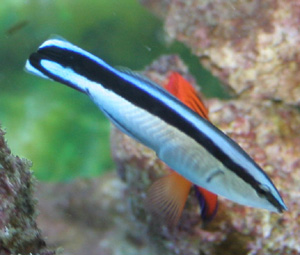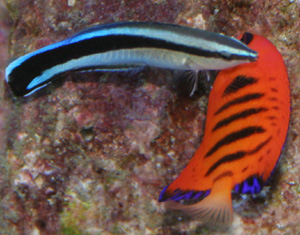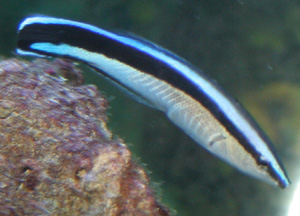Cleaner Wrasse – Labroides dimidatus
The cleaner wrasse, also known as bluestreak cleaner wrasse, comes from the Indo-Pacific ocean region. This is an attractive dwarf wrasse that should do well in a mature saltwater aquarium. They are (if healthy) active  members of a tank. They will continually attempt to clean parasites and groom other fish. members of a tank. They will continually attempt to clean parasites and groom other fish.
Maximum Size: The maximum length is 4.0 inches
Minimum Tank Size: 30 gallons or larger tank is appropriate
Care Level: The cleaner wrasse is a relatively hardy fish to maintain. If its needs are met, it should do well. On a scale of 1 –10, (10 being easy) it would rate a “7”. It should be introduced into a tank that is matured, and has plenty of prey/food items in the sand substrate.
Tank Conditions: Temperature 77 - 79°F; Specific gravity: 1.020 – 1.024; pH: 8.1 – 8.3; nitrate should be no more than 20 ppm.
 Color: The cleaner wrasse is a torpedo shaped fish. Its primary colors are dark blue and light blue. Dorsal fin may be red. The one in our 90-gallon tank adds color and activity and has become a favorite of several people. Color: The cleaner wrasse is a torpedo shaped fish. Its primary colors are dark blue and light blue. Dorsal fin may be red. The one in our 90-gallon tank adds color and activity and has become a favorite of several people.
Temperament: The cleaner wrasse is not overly aggressive and should do well with other non-aggressive tank mates. Do not put two cleaner wrasses in the same tank though – they will probably fight
Reef Compatible: Yes – the cleaner wrasse may nip at clams but other than that they should do well in a reef tank.
Diet: Carnivore - will take a varied diet of chopped shrimp, brine shrimp, chopped squid and clams as well as flake food. They should be fed 2-3 times each day. High quality vitamin enriched foods should be fed several times each week. 
Habitat: Provide with plenty of hiding places and rock for shelter. Good water quality is important. Wrasses’ need good water quality for health and color retention.
Lights: No special requirements are necessary.
Compatibility: Cleaner wrasse in general can be kept with small non-aggressive fish such as firefish and cardinalfish. They should not be housed with sharks, rays, large species wrasse, moray eels and groupers. It can be a problem if housed with triggerfish. Check with your aquarium shop if you plan on buying one of these fish.
|


 members of a tank. They will continually attempt to clean parasites and groom other fish.
members of a tank. They will continually attempt to clean parasites and groom other fish. Color: The cleaner wrasse is a torpedo shaped fish. Its primary colors are dark blue and light blue. Dorsal fin may be red. The one in our 90-gallon tank adds color and activity and has become a favorite of several people.
Color: The cleaner wrasse is a torpedo shaped fish. Its primary colors are dark blue and light blue. Dorsal fin may be red. The one in our 90-gallon tank adds color and activity and has become a favorite of several people. 